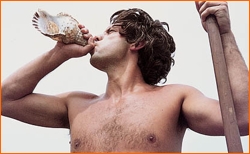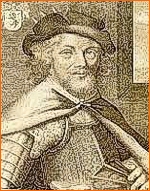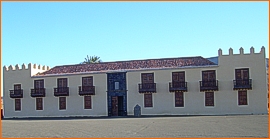|
The first inhabitants of Fuerteventura
It
seems that the Greeks, Phoenicians and Romans knew the Canary
Islands (Fuerteventura Romans called "Planaria", for its lack of
high elevations and "Capraria", by the abundance of goats).
There is a discrepancy in the time of arrival of the first
inhabitants of Fuerteventura, and some experts estimate that
came in the year 1,000 BC, but the oldest human remains dating
to the method of carbon-14, give an age of about 300 years
before of Christ.
Its origin comes from the north-western Africa, and its
predominant features were cromanoides and mediterranoides
 The
main reason for the arrival of these pioneers is the progressive
desertification of their homelands, which drove them to seek new
lands to settle, plus reasons of war and oppression in their
homelands. The
main reason for the arrival of these pioneers is the progressive
desertification of their homelands, which drove them to seek new
lands to settle, plus reasons of war and oppression in their
homelands.
What is unknown is how to reach the islands, as there is no
trace of vessels could be used. Apparently it was a King of
Mauritania (Juba II, year 40 BC), who took the initiative to
increase the sparse population of the Canary Islands.
It was a noble, peaceful and just, which is devoted to grazing,
agriculture and the collection of shellfish and fish.
At this time Fuerteventura was known as "Erbania", which comes
from "Ar-Bani" which means The Wall, in the Aboriginal language
of Gran Canaria, and referring to the defensive wall built in
Jandia Peninsula and the island separating into two kingdoms
faced in war.
The inhabitants of Fuerteventura called their island "Mahoh" in
their language meant "My Country"
The Conquest

It
was a pirate / French businessman Jean De Bethencourt, who in
1402 and an eminently economic interest (it was a cloth merchant
in Normandy, France, and sought Orchilla and Cochineal (moss and
insect of the natural dyes are extracted)), who began the
conquest of the Canary Islands after obtaining royal permission
of Henry III, King of Castile, with his partner Gadifer de la
Salle.
They get a fleet of several ships and 250 men and leave the
French port of La Rochelle on May 1, 1402. After several stops
for supplies in Galicia and Cadiz, where nearly all his men
deserted, leaving only 63, coming first to the island of
Alegranza, north of Lanzarote, and immediately went to Lanzarote,
where they founded the first settlement of the Canary Islands in
San Marcial de Rubicon (now Playa Blanca in the south of
Lanzarote).
Made several expeditions from Lanzarote to Fuerteventura, but
seeing that they needed more men and supplies to dominate the
Island, Jean de Bethencourt went to Spain to gather more
resources. and in 1404 established the first settlement in a
protected area of the island, which they called Betancuria, with
the most prosperous part of the island: Vega de Rio Palmas.
In 1404 and was finally able to subdue the two kingdoms into
which the island was divided: Maxorata and Jandia, separated by
a defensive wall. Each area was dominated by two local Reyes:
Guize in Maxorata and Ayoze in Jandia, who, seeing the
superiority of the invaders decided to surrender, and in return
received various perks and benefits.
In 1405 ended the conquest of Fuerteventura
After the Conquest

In
1476, the island of Fuerteventura becomes Lordship, depending on
the Catholic Kings and governed by Spanish soldiers and
influential families.
This period is characterized by colonization of Fuerteventura
attracted by the economic and development benefits that are
offered, mostly Galicians, Castilians and Andalusians, but also
came French, Italian and Dutch.
in 1812, the Cortes of Cadiz Fuerteventura prohibit the manors
and becomes part of the province of Gran Canaria, coinciding
with the creation of all the municipalities that currently make
Fuerteventura, Puerto del Rosario except dependent Tetir
Township.
It was created in 1834 when the municipality of Puerto Cabras,
old name of Puerto del Rosario, who would get the capital of the
island in 1860
|

 The
main reason for the arrival of these pioneers is the progressive
desertification of their homelands, which drove them to seek new
lands to settle, plus reasons of war and oppression in their
homelands.
The
main reason for the arrival of these pioneers is the progressive
desertification of their homelands, which drove them to seek new
lands to settle, plus reasons of war and oppression in their
homelands.
